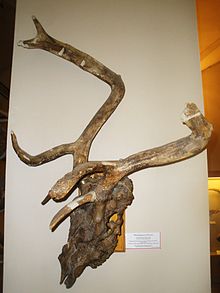Our website is made possible by displaying online advertisements to our visitors.
Please consider supporting us by disabling your ad blocker.
Praemegaceros
| Praemegaceros Temporal range: Early Pleistocene to Holocene
| |
|---|---|

| |
| Skull of P. obscurus | |

| |
| Skeleton of P. verticornis | |
| Scientific classification | |
| Domain: | Eukaryota |
| Kingdom: | Animalia |
| Phylum: | Chordata |
| Class: | Mammalia |
| Order: | Artiodactyla |
| Family: | Cervidae |
| Subfamily: | Cervinae |
| Genus: | †Praemegaceros Portis, 1920 |
| Species | |
| |
| Synonyms | |
| |
Praemegaceros is an extinct genus of deer, known from the Pleistocene and Holocene of Western Eurasia. Praemegaceros is considered to be a genus of "giant deer", with many species having an estimated body mass of around 400 kilograms (880 lb), considerably larger than most living deer.[1]
The genus contains the subgenera Praemegaceros, Orthogonoceros and Nesoleipoceros. It has sometimes been synonymised with Megaloceros and Megaceroides, but is regarded as a distinct genus by most studies.[2] Some authors have considered the genus closely related to Megaloceros, but this has been disputed by others.
The earliest species like P. obscurus and P. verticornis appeared in Europe between 2 and 1.5 million years ago.[3] The genus was widely distributed across Europe, West and Central Asia during the Early-Middle Pleistocene, with fossils having been discovered in France, Georgia, Germany, England, Greece, Israel, Italy, Romania, Russia Spain, Syria, and Tajikistan.[4][5][6] The genus was extinct in mainland Europe and Asia by end of the Middle Pleistocene. An insular species, P. cazioti survived into the Late Pleistocene and Holocene in isolation on the Sardinia-Corsica archipelago until around 5500 BCE.[7]
- ^ Croitor, Roman (2022-11-06). "Paleobiogeography of Crown Deer". Earth. 3 (4): 1138–1160. Bibcode:2022Earth...3.1138C. doi:10.3390/earth3040066. ISSN 2673-4834.
- ^ Croitor, R. (2006). "Taxonomy and systematics of large-sized deer of the genus Praemegaceros Portis, 1920 (Cervidae, Mammalia)". In Kahlke, R.D.; Maul, L.C.; Mazza, P.P.A. (eds.). Late Neogene and Quaternary Biodiversity and Evolution: Regional Developments and Interregional Correlations. Vol. 1. Stuttgart, Germany: Schweizerbart. pp. 91–116. ISBN 978-3-510-61383-0.
- ^ Rook, Lorenzo; Martínez-Navarro, Bienvenido (June 2010). "Villafranchian: The long story of a Plio-Pleistocene European large mammal biochronologic unit". Quaternary International. 219 (1–2): 134–144. Bibcode:2010QuInt.219..134R. doi:10.1016/j.quaint.2010.01.007.
- ^ "Fossilworks: Praemegaceros". fossilworks.org. Retrieved 17 December 2021.
- ^ Croitor, Roman (2006-11-15). "Taxonomy and systematics of large-sized deer of the genus Praemegaceros PORTIS, 1920 (Cervidae, Mammalia)". Courier Forschungsinstitut Senckenberg. 256 (256). ISSN 0341-4116.
- ^ Croitor, Roman (2014-09-30). "A skull of Praemegaceros pliotarandoides (Cervidae, Mammalia) from the Taman Peninsula (South-West Russia)". 7.
{{cite journal}}: Cite journal requires|journal=(help) - ^ Benzi, Valerio; Abbazzi, Laura; Bartolomei, Paolo; Esposito, Massimo; Fassò, Cecilia; Fonzo, Ornella; Giampieri, Roberto; Murgia, Francesco; Reyss, Jean-Louis (May 2007). "Radiocarbon and U-series dating of the endemic deer Praemegaceros cazioti (Depéret) from "Grotta Juntu", Sardinia". Journal of Archaeological Science. 34 (5): 790–794. Bibcode:2007JArSc..34..790B. doi:10.1016/j.jas.2006.09.001.
Previous Page Next Page


